| INTRODUCTION | DESCRIPTION | HISTORY | USAGE |
Please Click On Any Picture for a Larger Version
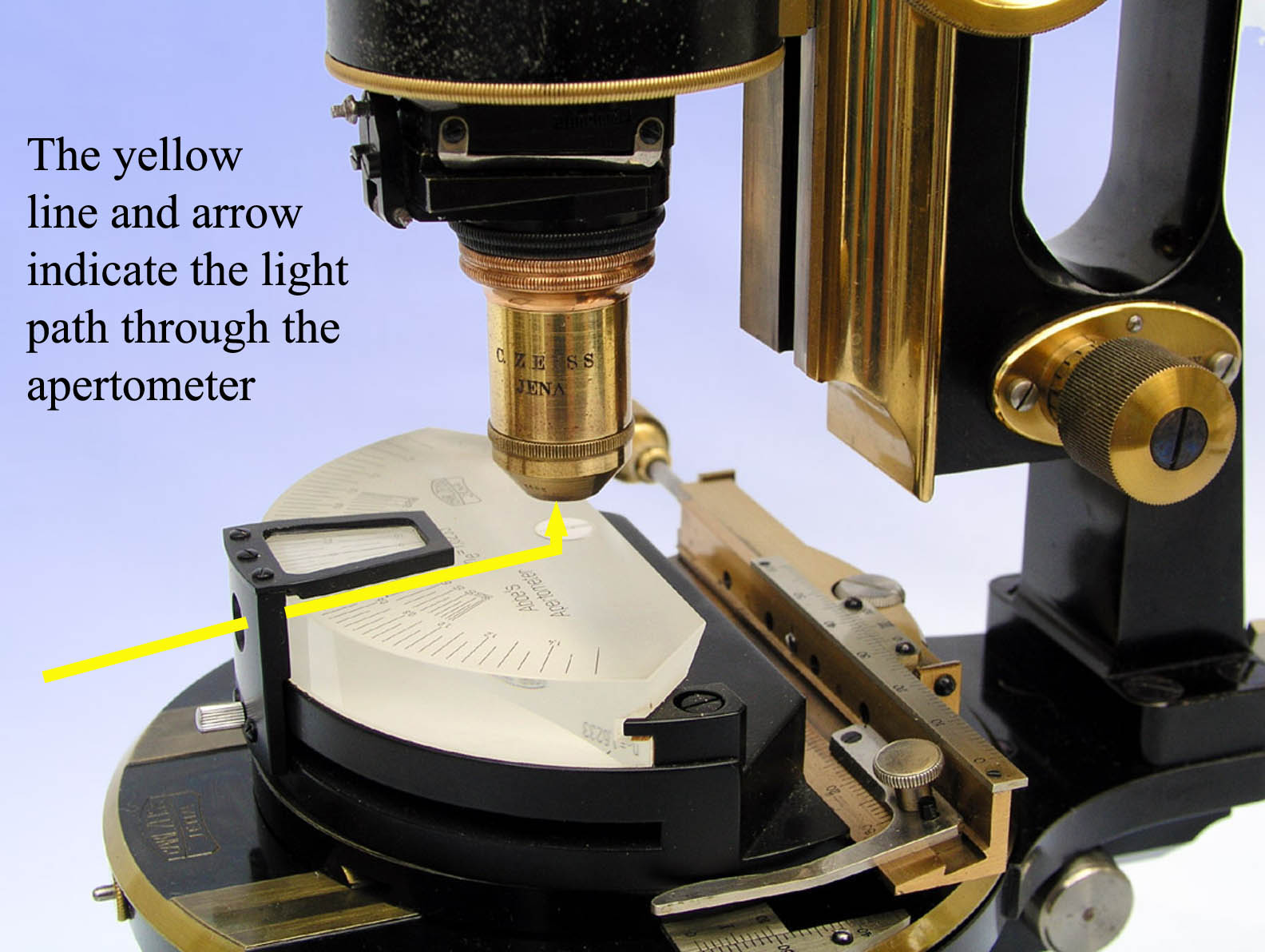
 An apertometer is used to measure numerical aperture, abbreviated NA or n.a. NA is the modern term which reflects the resolving power of an objective lens. In other words, the NA of a microscope objective is a measure of its ability to gather light and resolve fine specimen detail at a fixed object distance.
The image to the left shows a similar Abbe Apertometer in use. A special low power objective(not visible in this image) is in place at the bottom of the drawtube, which sits inside the main optical tube. In use in the traditional configuration, as shown in the image to the left, light is directed into the rounded side of the device. The light is directed through the 'opal glass' of the cursor, into the glass slab, and is reflected up through the cover slip and then through the objective. The 45 degree angle of the back of the glass directs the light upwards. The circle of opal glass on the side of the cursor has an 'X' in its center which lines up with the line on top of the cursor, registering on the scale. The special accessory objective at the end of the drawtube turns the drawtube itself into a microscope to view the back focal plane of the objective being studied. As the cursor is moved from right to left and left to right, the 'X' in the opal glass can be seen. When the X reaches the edge of the field on each side, the NA can be read directly off the glass slab. The two readings are averaged to give the correct mean value. Most monocular microscopes of the 19th and early 20th century, regardless of maker, had a thread at the end of the drawtube, usually a society thread. If the drawtube was not equipped with a society thread, it would need to be adapted to accept the special objective. Today it is faster and simpler to use a Bertrand lens or a Phase telescope instead of an objective on a drawtube. The author would like to thank James Solliday for supplying the image of the apertometer on a Zeiss microscope.
An apertometer is used to measure numerical aperture, abbreviated NA or n.a. NA is the modern term which reflects the resolving power of an objective lens. In other words, the NA of a microscope objective is a measure of its ability to gather light and resolve fine specimen detail at a fixed object distance.
The image to the left shows a similar Abbe Apertometer in use. A special low power objective(not visible in this image) is in place at the bottom of the drawtube, which sits inside the main optical tube. In use in the traditional configuration, as shown in the image to the left, light is directed into the rounded side of the device. The light is directed through the 'opal glass' of the cursor, into the glass slab, and is reflected up through the cover slip and then through the objective. The 45 degree angle of the back of the glass directs the light upwards. The circle of opal glass on the side of the cursor has an 'X' in its center which lines up with the line on top of the cursor, registering on the scale. The special accessory objective at the end of the drawtube turns the drawtube itself into a microscope to view the back focal plane of the objective being studied. As the cursor is moved from right to left and left to right, the 'X' in the opal glass can be seen. When the X reaches the edge of the field on each side, the NA can be read directly off the glass slab. The two readings are averaged to give the correct mean value. Most monocular microscopes of the 19th and early 20th century, regardless of maker, had a thread at the end of the drawtube, usually a society thread. If the drawtube was not equipped with a society thread, it would need to be adapted to accept the special objective. Today it is faster and simpler to use a Bertrand lens or a Phase telescope instead of an objective on a drawtube. The author would like to thank James Solliday for supplying the image of the apertometer on a Zeiss microscope. 
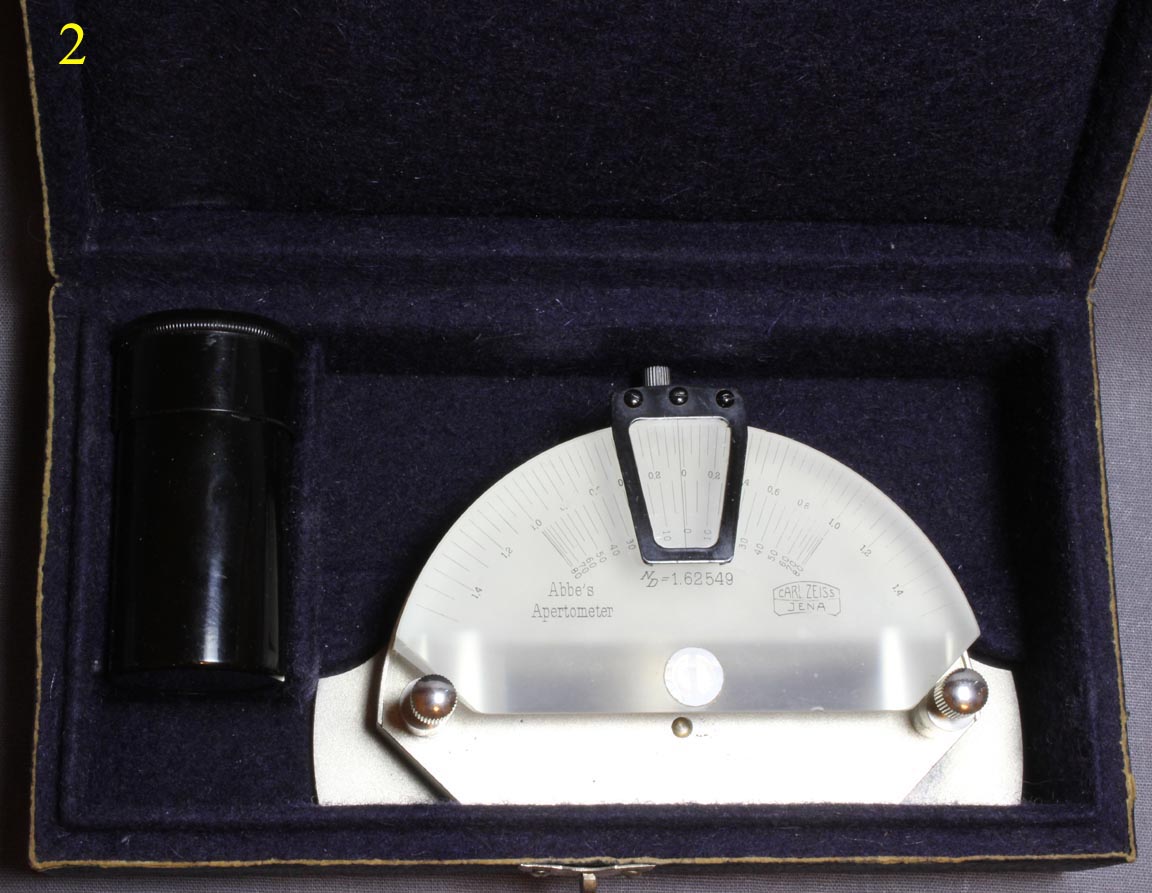
 This apertometer comes in a fitted black leather-covered case(fig 1), with gold lettering labeled
This apertometer comes in a fitted black leather-covered case(fig 1), with gold lettering labeled APERTOMETER, NACH ABBE.The outside dimensions of the case are about 160 x 79 x 52 mm. The top is slightly rounded. It is lined with dark blue velvet. Inside(fig 2) is the instrument and the special objective in its can. The can(fig 3) is black and labeled
CARL ZEISS,JENAin the insignia on the top of the can. The black objective(fig 3) is labeled with the same insignia and also
Apertometer, System, 690.The objective has a diaphragm on its distal end.
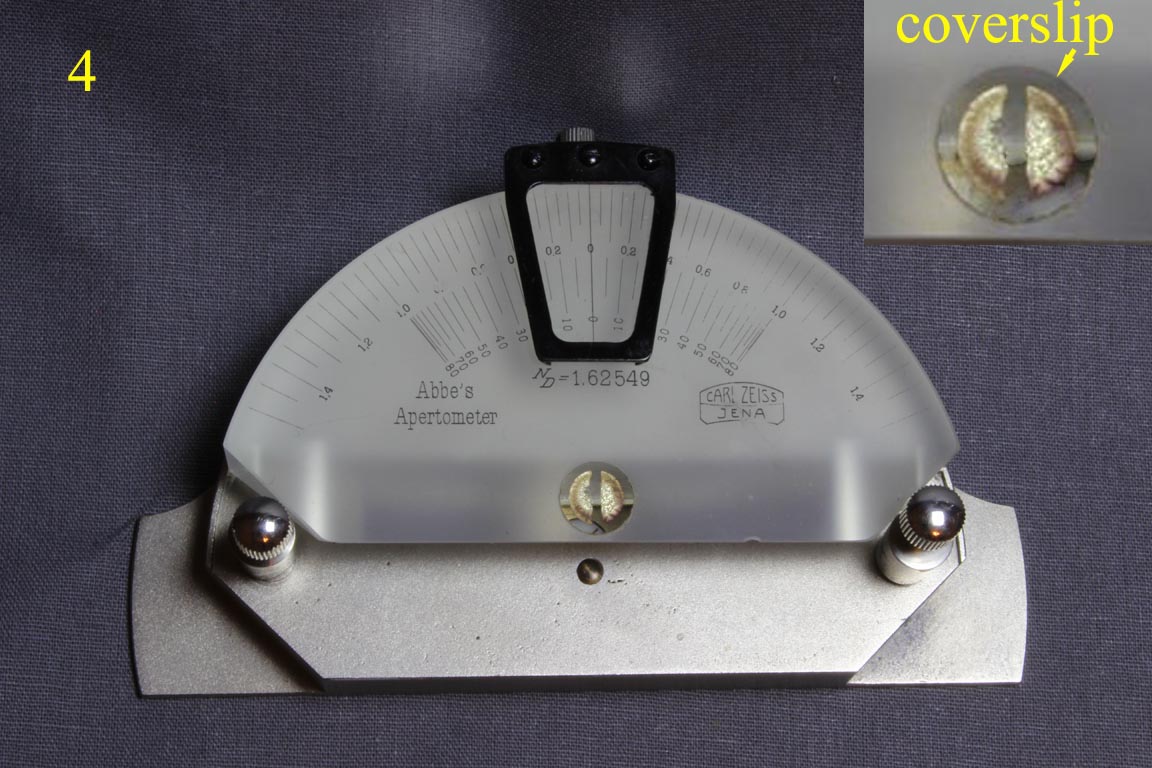
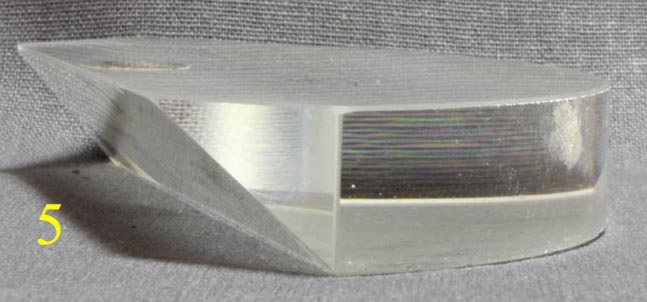
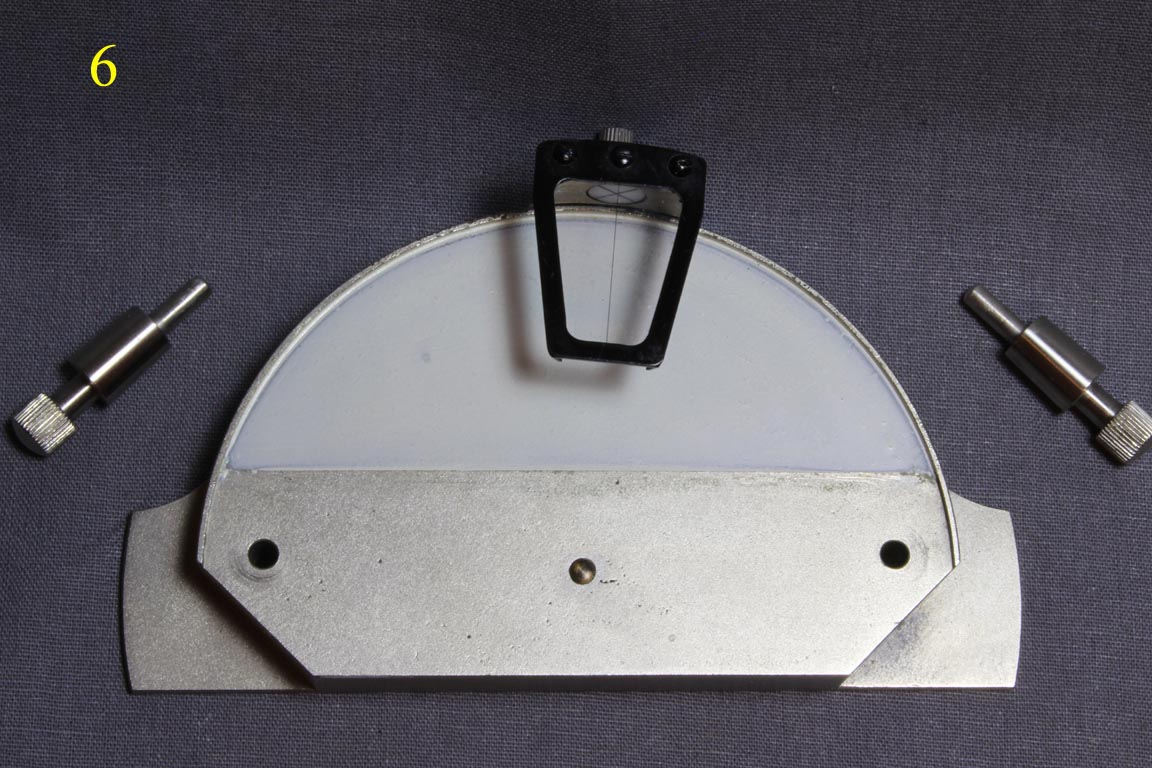 The apertometer itself consists of a semicircular glass slab of known refractive index, in this case, 1.62549, engraved on the glass. The flat top and bottom of the slab both have a frosted finish. It measures about 79 x 45 x 12.4 mm. The glass slab has on its flat top surface(fig 4) two sets of graduations, and near the flat edge at its midpoint, a small cover slip over a circular silver disk with a slit down its center(inset,fig 4). When viewed through the microscope, the edge of the slit on one hemicircle is quite straight and preserved, but on the other side it is ragged and some tiny parts of the hemicircular piece of silver on that side are scattered about. This in no way affects the use or performance of this instrument however. The flat side of the semicircular slab opposite its curved edge is angled at 45 degrees(fig 5). This serves to reflect the light entering horizontally from the curved side upward through the slit in the silver disk.
The bottom of the glass slab rests upon a metal support(fig 6). The metal support measures about 114 x 65 mm in maximal dimensions. The support is painted white in the area in which the glass slab sits. The glass slab registers against a lip on the front of the metal support, held up against it by two rods which rotate through an offset axis to allow fine adjustment of the tension and rotation of the glass slab on the metal support.
The apertometer itself consists of a semicircular glass slab of known refractive index, in this case, 1.62549, engraved on the glass. The flat top and bottom of the slab both have a frosted finish. It measures about 79 x 45 x 12.4 mm. The glass slab has on its flat top surface(fig 4) two sets of graduations, and near the flat edge at its midpoint, a small cover slip over a circular silver disk with a slit down its center(inset,fig 4). When viewed through the microscope, the edge of the slit on one hemicircle is quite straight and preserved, but on the other side it is ragged and some tiny parts of the hemicircular piece of silver on that side are scattered about. This in no way affects the use or performance of this instrument however. The flat side of the semicircular slab opposite its curved edge is angled at 45 degrees(fig 5). This serves to reflect the light entering horizontally from the curved side upward through the slit in the silver disk.
The bottom of the glass slab rests upon a metal support(fig 6). The metal support measures about 114 x 65 mm in maximal dimensions. The support is painted white in the area in which the glass slab sits. The glass slab registers against a lip on the front of the metal support, held up against it by two rods which rotate through an offset axis to allow fine adjustment of the tension and rotation of the glass slab on the metal support.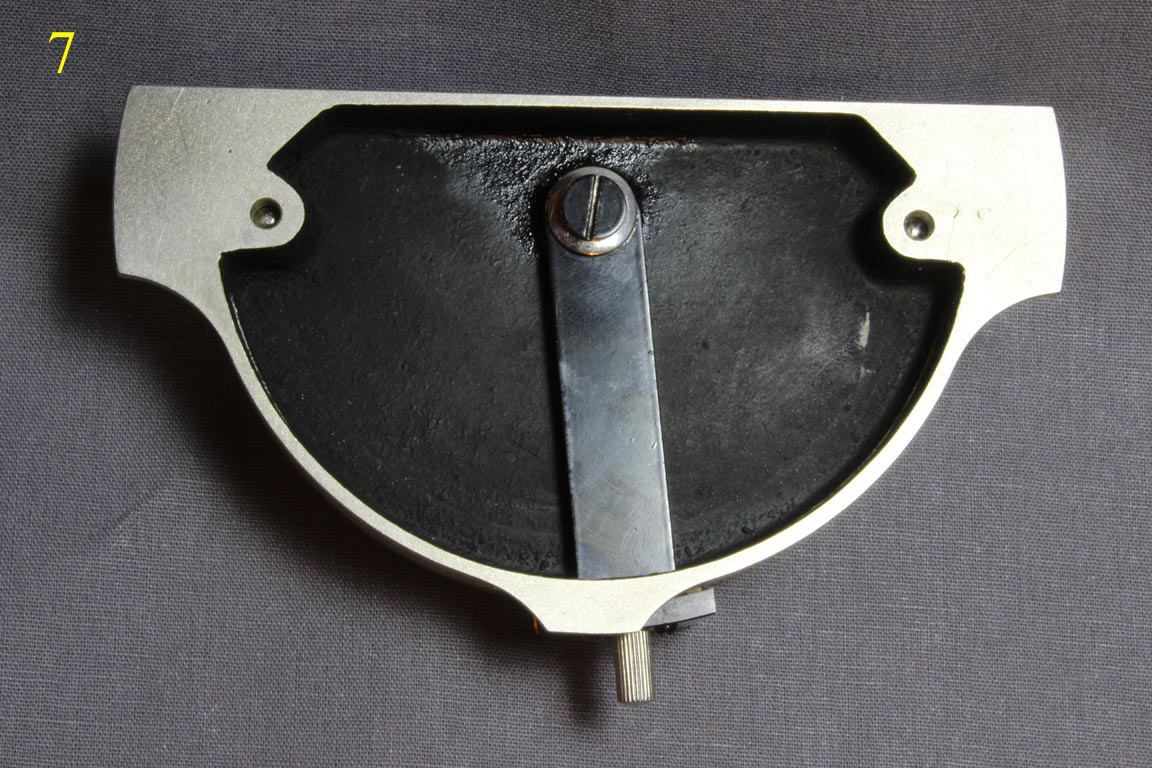
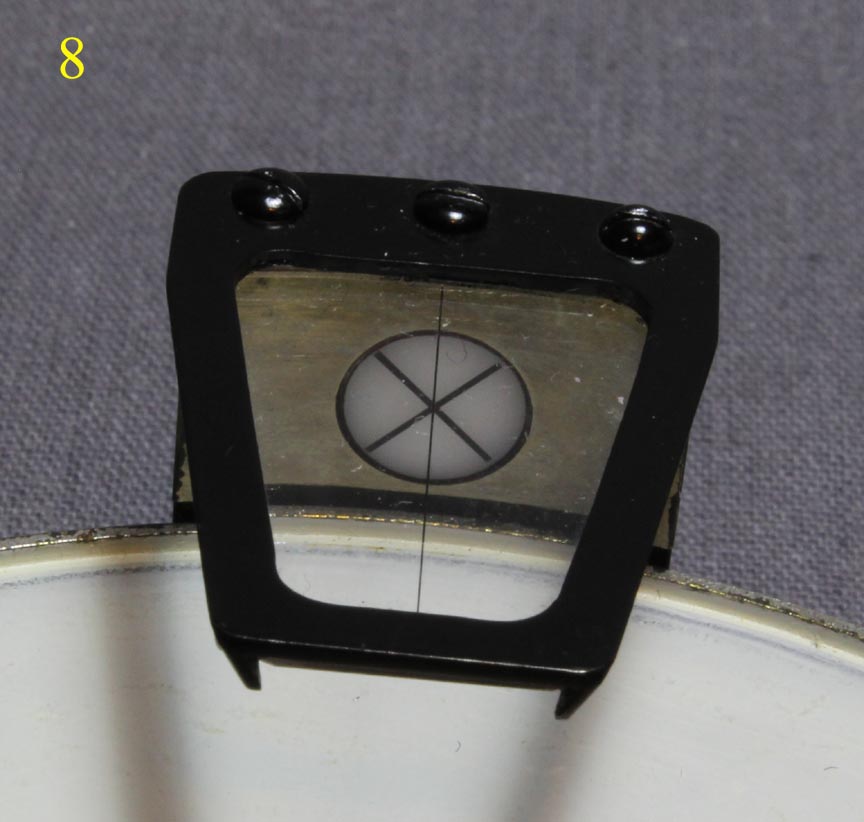 A radial arm is attached to the underside of the metal support(fig 7), and has its axis of rotation under the silver disk on top of the glass slab. Attached to this arm is a cursor(fig 8), which rides along the outer round surface of the glass slab. The cursor has a window on the surface facing the rounded edge of the glass part of the Apertometer which has a small circle of translucent 'opal glass' which has an 'X' in its center. A long index line on the top of the cursor enables the position of the cross to be read off of the two scales on top of the slab. The graduations closest to the curved surface are the scale for NA, while those closer to the silver disc indicate the simple angle so obtained. The cursor has a small knurled handle.
A radial arm is attached to the underside of the metal support(fig 7), and has its axis of rotation under the silver disk on top of the glass slab. Attached to this arm is a cursor(fig 8), which rides along the outer round surface of the glass slab. The cursor has a window on the surface facing the rounded edge of the glass part of the Apertometer which has a small circle of translucent 'opal glass' which has an 'X' in its center. A long index line on the top of the cursor enables the position of the cross to be read off of the two scales on top of the slab. The graduations closest to the curved surface are the scale for NA, while those closer to the silver disc indicate the simple angle so obtained. The cursor has a small knurled handle. 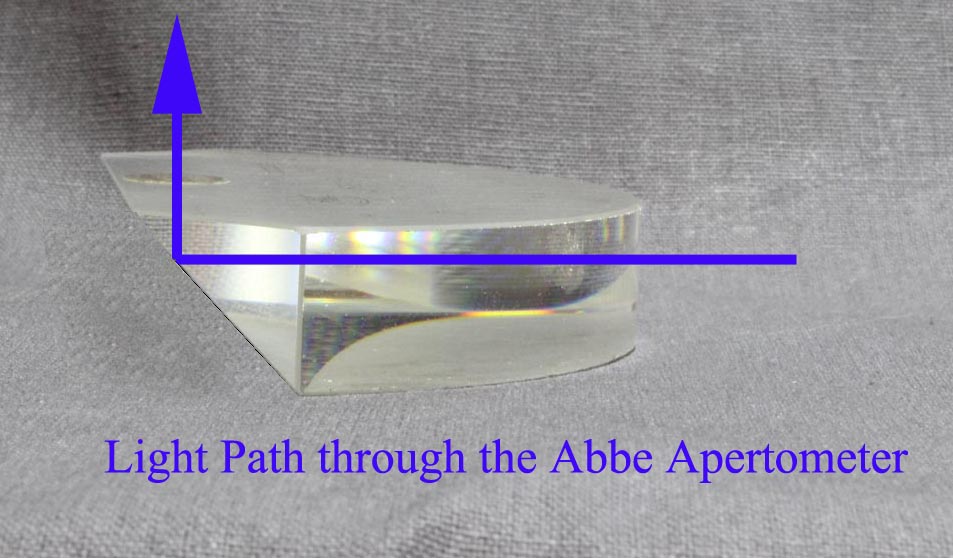
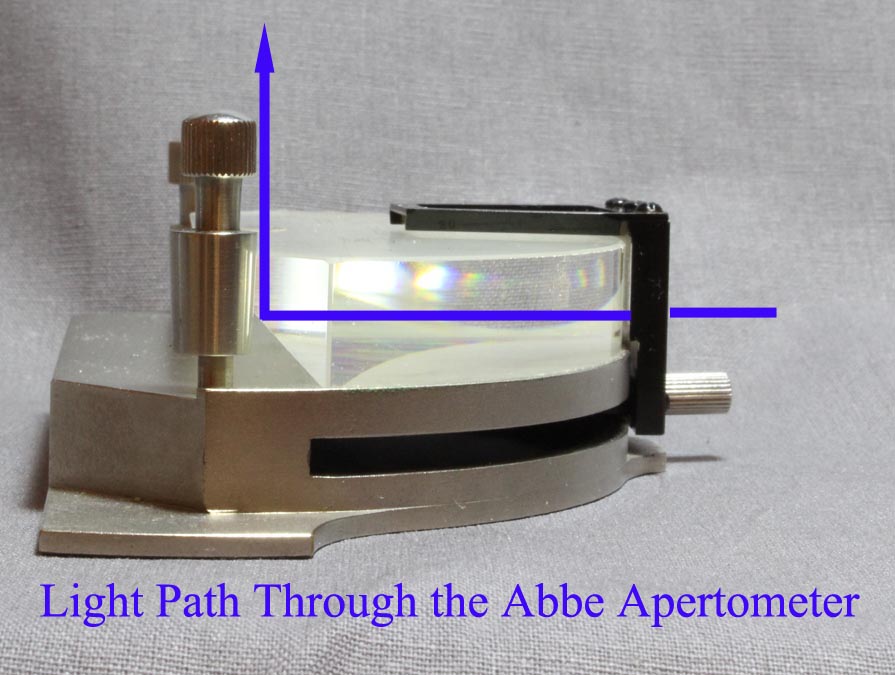 The light path when using the apertometer is shown in the images. Light is directed horizontally towards the curved side, and is reflected by the 45 degree angle at the back of the glass upwards through the silver disc opening. The light source may need to be repositioned as the cursor is moved. Using the Abbe apertometer to determine NA is usually reasonably accurate, provided instructions for its use are carefully followed. The instructions by Zeiss leave out a few helpful details on improving accuracy mentioned by Spitta and in greater detail by Hartridge. Hartridge goes further to make several suggestions for improving accuracy employing a reversed light path, that is with the light directed down the optical tube and the NA determined by the pattern of light falling on the apertometer. In addition, several other caveats about Hartridge's method make his method quite tedious. That degree of accuracy, though it may be improved with his method, is not neccesary for ordinary work, as the errors occurring when the device is employed when the device is used as originally intended, are too small to be detected by the human eye. That is, the human eye cannot differentiate a change in resolution with small changes in NA. A satisfactory result can be obtained by combining the instructions by Zeiss and the precautions mentioned by Spitta.
The light path when using the apertometer is shown in the images. Light is directed horizontally towards the curved side, and is reflected by the 45 degree angle at the back of the glass upwards through the silver disc opening. The light source may need to be repositioned as the cursor is moved. Using the Abbe apertometer to determine NA is usually reasonably accurate, provided instructions for its use are carefully followed. The instructions by Zeiss leave out a few helpful details on improving accuracy mentioned by Spitta and in greater detail by Hartridge. Hartridge goes further to make several suggestions for improving accuracy employing a reversed light path, that is with the light directed down the optical tube and the NA determined by the pattern of light falling on the apertometer. In addition, several other caveats about Hartridge's method make his method quite tedious. That degree of accuracy, though it may be improved with his method, is not neccesary for ordinary work, as the errors occurring when the device is employed when the device is used as originally intended, are too small to be detected by the human eye. That is, the human eye cannot differentiate a change in resolution with small changes in NA. A satisfactory result can be obtained by combining the instructions by Zeiss and the precautions mentioned by Spitta.  VIEW OF THE EDGE OF THE SLIT UNDER THE MICROSCOPE
VIEW OF THE EDGE OF THE SLIT UNDER THE MICROSCOPE
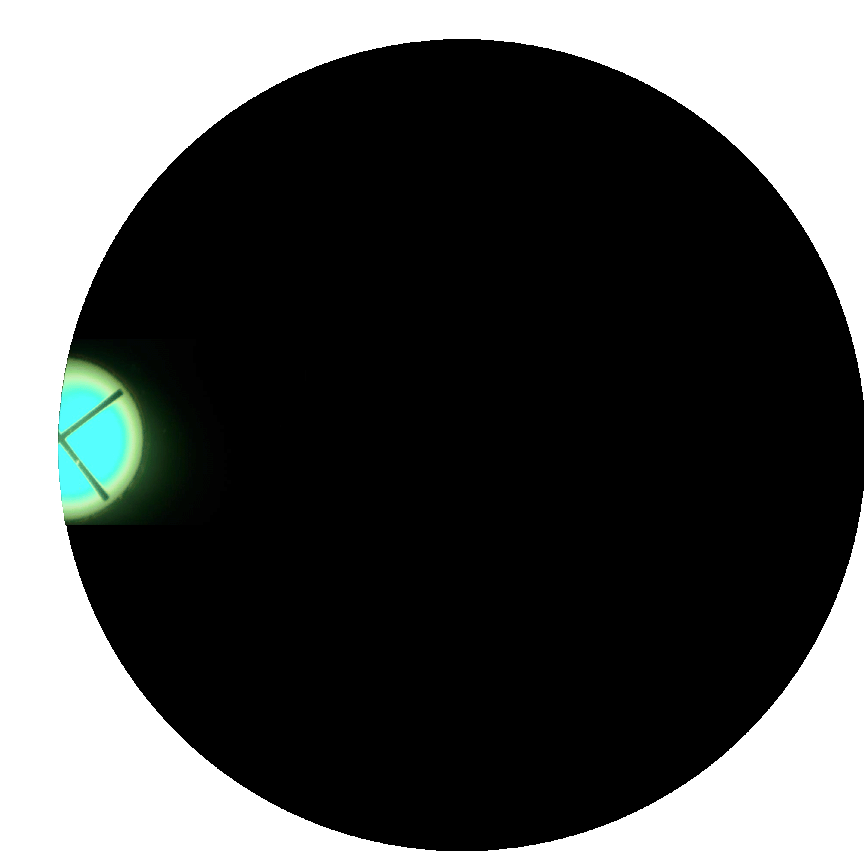 VIEW OF THE X IN THE CURSOR AS VIEWED THROUGH A PHASE TELESCOPE OR BERTRAND LENS AS IT APPROACHES THE EDGE OF THE FIELD
VIEW OF THE X IN THE CURSOR AS VIEWED THROUGH A PHASE TELESCOPE OR BERTRAND LENS AS IT APPROACHES THE EDGE OF THE FIELD
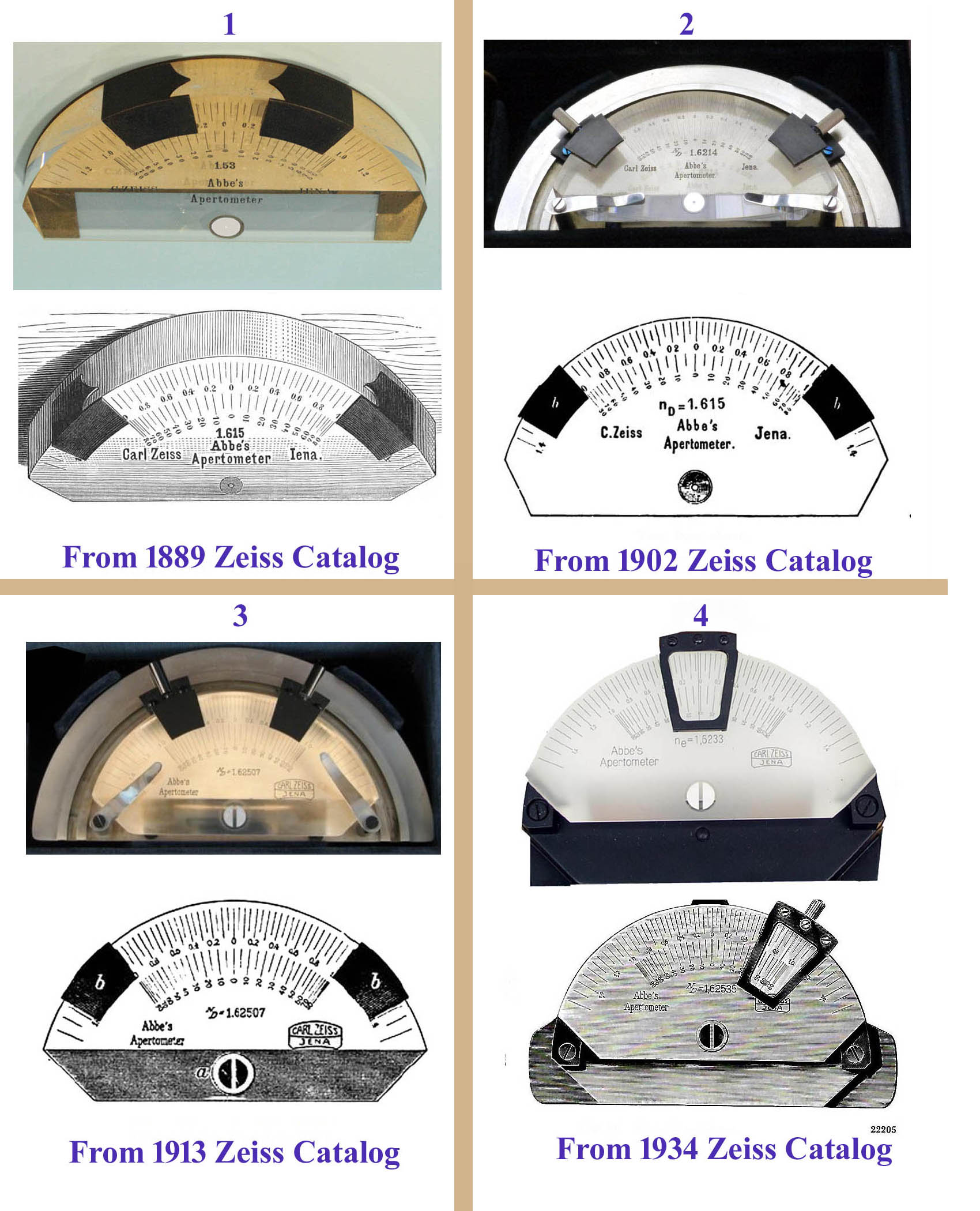
Xon a piece of
opal glass. I found the cursor type in Zeiss Catalogs starting in 1924. The double indicator type was still offered in the Zeiss catalog of 1913; therefore the change occurred sometime between 1913 and 1924. Spitta's book of 1920 still showed the double indicator type. Unfortunately I have been unable to locate any dated catalog or instruction manual containing an entry for the apertometer after 1913 and before 1924 to further narrow down the search. Since the 1920 edition of Spitta still showed the double indicator version, it is reasonable to conclude the new model with a single cursor was first produced in the 1920's. I would greatly appreciate information from anyone with catalog entries for the Abbe apertometer after 1913 and before 1924 to further narrow this down.